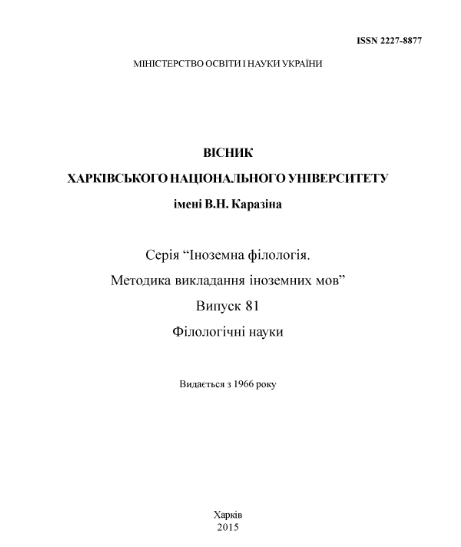Cognitive-discursive instruments of analysing Ukrainian translations of English parodies
Keywords:
conceptual blending theory, parody, precedent text, translation
Abstract
The article presents the results of implementing the instrumental notions of the conceptual blending theory in the analysis of Ukrainian translations of English parodies. These instruments of analysis explain cognitive mechanisms ensuring recognisability of the original parody as well as the precedent text that is the source of the parody. Applying the instrumental notions of the conceptual blending theory builds the algorithm of analysis to avoid subjectivity.
Downloads
Download data is not yet available.
References
1. Захаренко И. В. Прецедентное имя и прецедентное высказывание как символы прецедентных феноменов / И. В. Захаренко, В. В. Красных, Д. Б. Гудков, Д. В. Багаева // Язык, сознание, коммуникация: сб. статей. – М.: Филология, 1997. – Вып. 1. – С. 82-103.
2. Ребрій О. В. Відтворення прецедентності віршованого пародійного тексту в англо-українському перекладі / О. В. Ребрій // Науковий вісник Херсонського державного університету. Сер. : Лінгвістика. – Херсон : ХДУ, 2009. – Вип. 10. – С. 277–283.
3. Attardo S. Script Theory Revis(it)ed: Joke Similarity and Joke Representation Model / S. Attardo, V. Raskin // Humor: International Journal of Humor Research. – 1991. – № 4 (3/4). – P. 293-348.
4. Fauconnier G. The way we think: Conceptual blending and the mind’s hidden complexities / G. Fauconnier, M. Turner. – New York: Basic Books, 2002. – 440 p.
5. Martynyuk A. Metaphoric political insults and humour: Cognitive analysis / A. Martynyuk // US-China Foreign Language. – 2015. – № 13 (1). – P. 814-820.
REFERENCES
Attardo, S., Raskin, V. (1991) Script Theory Revis(it)ed: Joke Similarity and Joke Representation Model. Humor: International Journal of Humor Research, 4 (3/4), 293-348.
Fauconnier, G. (2002). The way we think: Conceptual blending and the mind’s hidden complexities. New York: Basic Books.
Martynyuk, A. (2015) Metaphoric political insults and humour: Cognitive analysis. US-China Foreign Language, 13 (1), 814-820.
Rebriy, O.V. (2009). Vidtvorennya pretsedentnosti virshovanoho parodiynoho tekstu v anhlo-ukrayins'komu perekladi [Rendering precedence of a poetic parody text in the English-Ukrainian translation]. Naukovyy visnyk Khersons'koho derzhavnoho universytetu – Scientific papers of Kherson state university, 10, 277–283. (in Ukrainian).
Zaharenko, I.V., Krasnyh, V.V., Gudkov, D.B., Bagaeva, D.V. (1997). Precedentnoe imja i precedentnoe vyskazyvanie kak simvoly precedentnyh fenomenov [Precedent Name and Precedent Utterance as Symbols of Precedent Phenomena]. Jazyk, soznanie, kommunikacija – Language, Mind, Communication, 1, 82-103. (in Russian).
2. Ребрій О. В. Відтворення прецедентності віршованого пародійного тексту в англо-українському перекладі / О. В. Ребрій // Науковий вісник Херсонського державного університету. Сер. : Лінгвістика. – Херсон : ХДУ, 2009. – Вип. 10. – С. 277–283.
3. Attardo S. Script Theory Revis(it)ed: Joke Similarity and Joke Representation Model / S. Attardo, V. Raskin // Humor: International Journal of Humor Research. – 1991. – № 4 (3/4). – P. 293-348.
4. Fauconnier G. The way we think: Conceptual blending and the mind’s hidden complexities / G. Fauconnier, M. Turner. – New York: Basic Books, 2002. – 440 p.
5. Martynyuk A. Metaphoric political insults and humour: Cognitive analysis / A. Martynyuk // US-China Foreign Language. – 2015. – № 13 (1). – P. 814-820.
REFERENCES
Attardo, S., Raskin, V. (1991) Script Theory Revis(it)ed: Joke Similarity and Joke Representation Model. Humor: International Journal of Humor Research, 4 (3/4), 293-348.
Fauconnier, G. (2002). The way we think: Conceptual blending and the mind’s hidden complexities. New York: Basic Books.
Martynyuk, A. (2015) Metaphoric political insults and humour: Cognitive analysis. US-China Foreign Language, 13 (1), 814-820.
Rebriy, O.V. (2009). Vidtvorennya pretsedentnosti virshovanoho parodiynoho tekstu v anhlo-ukrayins'komu perekladi [Rendering precedence of a poetic parody text in the English-Ukrainian translation]. Naukovyy visnyk Khersons'koho derzhavnoho universytetu – Scientific papers of Kherson state university, 10, 277–283. (in Ukrainian).
Zaharenko, I.V., Krasnyh, V.V., Gudkov, D.B., Bagaeva, D.V. (1997). Precedentnoe imja i precedentnoe vyskazyvanie kak simvoly precedentnyh fenomenov [Precedent Name and Precedent Utterance as Symbols of Precedent Phenomena]. Jazyk, soznanie, kommunikacija – Language, Mind, Communication, 1, 82-103. (in Russian).
Published
2016-03-07
How to Cite
Богуславська, Л. А. (2016). Cognitive-discursive instruments of analysing Ukrainian translations of English parodies. The Journal of V.N. Karazin Kharkiv National University. Series: Foreign Philology. Methods of Foreign Language Teaching, (81), 293-297. Retrieved from https://periodicals.karazin.ua/foreignphilology/article/view/5373
Section
Comparative and translation studies




